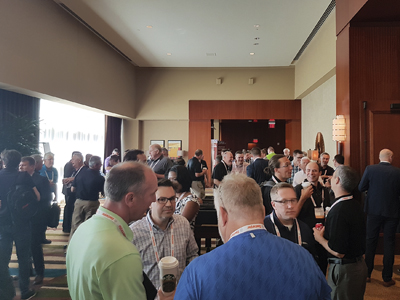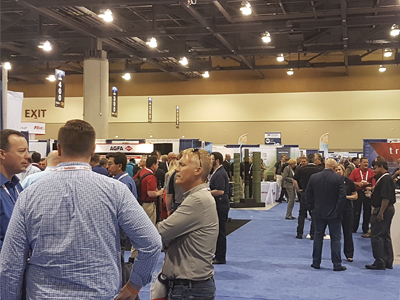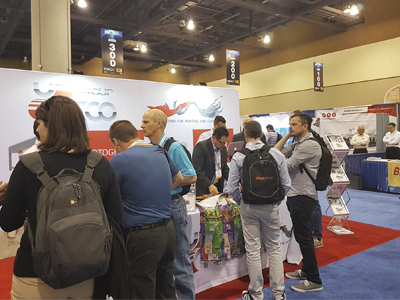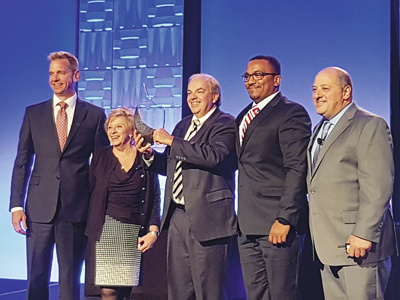Mark Andy won the 2017 FTA Technical Innovation Award for its Digital
Series press platform (L-R) Steve Schulte (Mark Andy), Shelley Rubin (FTA manager of educational services), Ray Dickinson, Joe Calmese (both Mark Andy) and Joe Tuccitto (FTA director of education)
Under the heat of the Arizona sun, the FTA held its Forum and Info*Flex 2017 exhibition from 30 April-3 May, bringing together flexo professionals and suppliers from across North America to the city of Phoenix. Michal Lodej reports.
With the Forum and Info*Flex events co-located, it provides printers with the perfect combination of educational seminars and the opportunity to speak with suppliers while, importantly, keeping the two separate.
Many topics were covered over the four days of the conference and the Flexo: Legals, markets and logistics session took the time to look at the state of the industry today and which predications were being made for its future.
Rick Rosenberger, operations manager for Hart Industries, referred to data collected by the FTA. He said, ‘Packaging sales are set to rise to $1 trillion globally by 2020. This is on the back of an 18% growth rate in flexo in the last four years.’
Growth in the sector is obviously good news, but in no way does it mean printers can relax, instead they need to be thinking about how they will respond to this growth.
Dan Muenzer, vice president of marketing, Constantia, said, ‘The information tells us that packaging is growing but what we should be looking at is our efficiency. It’s not about just printing metres and metres of labels anymore. A ruthless approach to efficiency is what will improve profits. Digital printing isn’t winning, it’s just pushing flexo to improve itself, 50% of respondents said decreasing time to make jobs ready and speed to market are most important challenges they are facing.’
Mr Muenzer continued, ‘The label industry is hand to hand combat. Flexo is uniquely placed to help us but it’s not all about flexo. Customers don’t care about the technology that brings their products to them, they just want the results. Some packaging doesn’t use labels at all. The beer industry is changing, 40% is in glass bottles and so they need labels, but that means 60% is now in cans, which don’t use labels.’

Converters from across North America gathered for the FTA’s Forum
Statistics do not always paint the full picture however. Kurt Hudson from Actega pointed out, ‘Flexo as a sector is growing, but as a technology it has a falling market share, this can result in commoditisation, and cause a slowing of investment in the technology.
‘Change the way that you compete, if you are just keeping up with the Joneses then you’re not doing anything differently. Flexo may not be enough, we’re not just printing labels, we’re constructing them too. Always then keep your entire process in mind, you may have to think about multiple processes.’
Ink matters
The All About Ink seminar was, you guessed it, focused on ink and how different types of inks and varnishes can help to sell a product. Seventy-five percent of purchasing decisions are made in advance, so if a product is not on the list, it has a lot of work to do to get into the basket. The good news is that 70% of items which are picked up in a shop are purchased, but a package only has three to seven seconds to grab a customer’s attention before that can happen. Engaging more senses gives a better chance of grabbing a customer’s attention. Special effect coatings such as shiny, tactile or even scented coatings, all stimulate a different sense.
Helen Rallis, Sun Chemical’s field product manager for coatings, said, ‘The most common requested coatings are for matt soft touch and paper feel effects. Matt coatings also help to cut the glare of the lights in a shop and so help the designs to become more visible on the shelf.’
Special coatings however bring with them special requirements, and need to treated differently. Ms Rallis continued, ‘Scented coatings release the scent by friction, so if you produce this type of package you must make sure it not rubbed against anything before it gets to market. As a rule of thumb, the more special effects you can add to a package the better, but obviously you need to be able to handle running a job with all these different elements. This could mean that you need to invest in new aniloxes. You also need to make sure the coatings are properly handled on the press using mixers and pumps where required. As always make sure you test any new coatings first before going into any production runs.’
Derek Awalt, senior product manager at Digimarc, developers of digital watermarking, spoke about connected packaging. Connected packaging includes active packaging, interactive packaging and intelligent packaging. Mr Awalt said, ‘Consumers want engagement, and today with smart phones, everyone has the compatibility to connect. Generation Y [generation of people born during the 1980s and early 1990s] are using their phones while shopping, and are willing to scan items while they do it. Consumers want more information, they want full transparency. How do you connect with consumers when legal requirements for packaging takes up more and more room? A smart label can help with this.’
Shining and glistening packaging is always able to catch the eye, and usually requires the use of metallic inks. Kevin Schilling, technologies specialist at Anderson and Vreeland, gave some advice for those using them, he said, ‘Metallic inks are available in different shapes and sizes and you need to know which particles you are dealing with. Starting with the basics, a courser pigment needs a larger BCM and a finer pigment needs a smaller BCM.
‘You also need to know your substrate, and in particular the substrate’s surface. The rougher the surface the less brilliant a metallic finish will look, while a smooth one will produce the most dazzling results.’
Streamline the process
Malcolm Keith, professor of Graphic Communication at Cal Poly State University, spoke about how all printers of any size or turnover, can streamline their production.
He said, ‘Before improving any part of your process, you need to have stable process. Control is a prerequisite, you need to be able to control your process if you want to measure and track your progress.’
Arguably the biggest delay in all pressrooms is changeover time. Mr Keith asked, ‘What’s your average change’ over time and what strategy can you use to improve it? Before revealing his target is 20-50 minutes for a narrow web press and 30-60 minutes for a wide web press. He did apologise if anyone thought his targets were too aggressive.
The professor played a video which showed a time lapse of a press changeover. He also asked the operator to draw a spaghetti map of what he believed to be his set up routine. The video showed the reality of what goes into setting up a press and revealed that the operator makes more trips across the press room than even he realised.
Set up racks, which are not high tech or expensive, help to move items to the press and stop the operator going back and forth. Other low-cost ways of saving time could involve shadow boards and colour coded tools to help speed up an operator’s job, even if it is only saves a couple of minutes.
Professor Keith told attendees, ‘Look at pit stops in racing, see how much thought has gone into them. You need to put as much thought into your make readies. Set up is not a value-added process, if you think it is then start putting it onto your invoices as a standalone charge and see what your customers say.’
The next topic was press spoilage, out of specification prints or defects, these need to measured and controlled if you are to respond to them. Professor Keith told the audience, ‘You need to know what you are able to produce. If the job specs are over your available production results then you have a problem you will never solve. Do you have a production maintenance programme? Less than 2% of your time should be on unplanned downtime. When things get busy, it’s too easy to postpone maintenance. Involve your operators and as many other staff as possible into the maintenance programme, the more they know the quicker problems can be identified.’
Another common bug bear is press speed. Do you run at your press as fast as it can go while maintaining quality? And if not, why can’t you run at full speed? His target is that presses should be running at least 70% of full speed for short runs and at least 90% of full speed on long runs.
Other pressure points
The professor identified other areas in which printers could streamline their process.
Reprints – this target should be zero. You need to have a process that ensures you will not be doing any reprints.
Plate remakes, where do you find your plate defects? The goal here is to find zero defects on the press, and instead find them at the pre-press stage.
Other non-chargeable time, how long do you wait for your consumables? Whatever you wait for needs to be eliminated so a robust pre-make ready programme needs to be established and all waiting time needs to
be cut.
Shift variation, how does the day shift compare to the night shift in terms of productivity, and if there are differences why? There should be a target of less than 2% variation between the two different shifts.
Productivity is only available if you measure it, but here there is a warning, don’t measure absolutely everything, measure what you want to control and improve. An important part of this is to engage staff, so that they can be part of your efforts too.
A chance to exhibit
From 1-3 May, after a morning of learning attendees were then given the chance to wander the halls of Info*Flex 2017 which this year featured more than 300 table top booth spaces occupied by 240 exhibiting companies. Not being the type of exhibition to hold big pieces of kit on huge stands, the show allows visitors to talk and network with suppliers of machinery, consumables, software and numerous other components crucial to flexography.

The halls of Info*Flex were open for three days
With its traditional low-key exhibitor presence, new product launches are not commonly made at Info*Flex, however for those selling software it has all the space you need. QuadTech demonstrated new colour measurement capabilities developed into its ColorTrack system which was launched at drupa 2016.
ColorTrack provides fast and accurate press-side correction of ink formulations. Without any hardware modifications to the press, the software integrates with ink recipe software to not only simplify workflow, but also reduce the number of ink corrections
needed to achieve accurate colour.
One of the shows main attraction is the opportunities it presents to meet people. Networking is a crucial part of any business and there is plenty of going on in the halls of the exhibition and the surrounding bars. The laid-back atmosphere, helps those conversations flourish, without the noise of a press demonstration drowning out conversation.

Info*Flex gave visitors the chance to speak directly to industry suppliers
Read the full June issue here






